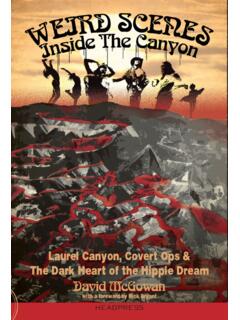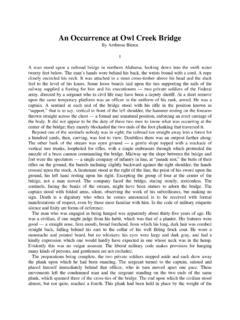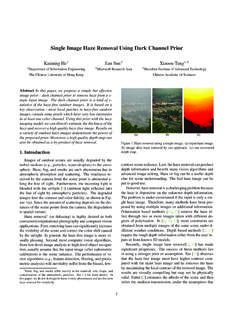Transcription of Orkin - Insect Identification Guide
1 THE Insect . Identification . Guide . Some can lift over 50 times their body weight. Others taste with their feet, or have ears on their legs. It's the strange and fascinating world of that are undeniably vital to our daily lives. Insects pollinate our crops, and supply us with products like honey, silk and medicine. They also serve as food for fish and birds, and are crucial for research on such topics as heredity and pollution. The O. Orkin Insect Zoo, located inside the Smithsonian Institution's National Museum of Natural History, will change the way you view insects and their relatives.
2 Over a million visitors each year are discovering their global ecological importance, and the interdependent relationship between insects and humans. You may not welcome insects into your home, but life as we know it wouldn't exist without them. Orkin Pest Control is proud to support the O. Orkin Insect Zoo. O. Orkin . Insect ZOO. NATIONAL MUSEUM of NATURAL HISTORY. MONARCH. CATERPILLAR/BUTTERFLY. Danaus plexippus APPEARANCE: CATERPILLAR: Up to 2-3/4 inches long; black with white and yellow bands. BUTTERFLY: Wingspan 3-1/2 to four inches long; wings brownish- orange; black to dark brown veins.
3 Two rows of orange and/or white spots. Actual Size HABITS: Found primarily in meadows, roadsides and sandy areas where milkweeds grow. DIET: Caterpillars feed on milkweed foliage, flower buds and milky juice; butterflies feed on flowers. REPRODUCTION: Females lay eggs along migration northward;. fully grown caterpillar changes to barrel-shaped, leaf-green pupa with gold dots; process from egg to butterfly takes about four weeks. OTHER INFORMATION: Butterflies are capable of flying 2,000 miles during southern migration each autumn, often stopping in same rest spots every year.
4 Actual Size 3. HOUSE FLY. Musca domestica APPEARANCE: About 1/4 inch long; light gray with four lengthwise stripes on thorax; large reddish compound eyes. HABITS: May migrate up to 20 miles from birthplace, but most stay within one or two miles; 98% of flies caught in houses are house flies. DIET: Feed on a wide variety of foods, but prefer Actual Size liquids containing sweet or decaying material; larvae feed on moist food rich in organic matter. REPRODUCTION: Eggs laid singly, but in clusters of 75-150; female may lay over 500 eggs in a lifetime; eggs hatch in 10-24 hours; entire life cycle completed in less than seven days.
5 OTHER INFORMATION: Associated with a number of filth-related diseases. APPLE MAGGOT FLY. Rhagoletis pomonella APPEARANCE: 1/4 inch long; shiny black to tan with yellowish-white lines; orange head;. wings have black F-shaped bands. HABITS: Found primarily in orchards and the edges of deciduous woods with native hawthorns, blueberry bushes or western snowberries. DIET: Adults feed on leaves and fruit;. larvae feed on pulp of fruit. REPRODUCTION: Eggs inserted singly into fruit skin; fully grown larvae tunnel out, drop to the Actual Size ground and pupate in the soil.
6 OTHER INFORMATION: Males perform courtship dances, waving their wings while females watch. 4. PYRALIS FIREFLY. Photinus pyralis APPEARANCE: 1/2 inch long;. blackish-brown with dull edges on sides and down middle;. above head is rosy pink covering with dull yellow edges and black spot in center. HABITS: Nocturnal; live in moist places under debris, bark or decaying matter on the ground; on summer nights, blink their Actual Size yellow lights to attract mates. DIET: Adults do not feed; larvae feed on Insect larvae, slugs and snails. REPRODUCTION: Eggs are left on damp soil; larvae overwinter, then pupate in moist soil.
7 OTHER INFORMATION: Female does not fly. HONEY BEE. Apis mellifera APPEARANCE: Up to 5/8 inch long; reddish-brown and black with paler, orange-yellow rings on abdomen; two pairs of wings. Actual Size HABITS: Very social; hive in hollow trees and in hives kept by beekeepers; pollinate crops and produce honey. DIET: Adults drink nectar and eat honey. REPRODUCTION: Queen lays eggs at intervals, producing colonies of 60,000 to 80,000 members; life span is usually two to three years for the queen; drones die after mating. OTHER INFORMATION: Workers have a stinger that is used when colony is threatened; members of hive pass food to one another mixed with saliva to form a chemical bond.
8 5. CARPENTER BEE. Genus Xylocopa APPEARANCE: Large, about one inch, resemble bumblebees; some species may have a blue-black, green or purple metallic sheen; no hair on abdomen. HABITS: Often burrow into the exposed, unfinished dry wood of buildings, telephone poles, fence posts and bridges; prefer softer woods for nesting; not social insects, although individuals may establish burrows close to each other. DIET: Pollen and nectar. REPRODUCTION: Complete one generation per year in most of the ; mature from egg to adult in 84 to 99 days; female furnishes nest with bee bread, a mixture of pollen Actual Size and regurgitated nectar, and lays an egg on top of it.
9 OTHER INFORMATION: Males do not sting, but females have a potent sting which they rarely use; make loud buzzing noise when flying. APPEARANCE: Variety of shapes and colors; can be distinguished from bees by their smooth, rather than WASPS. hairy, bodies; 1/2 inch to 3/4 inch long. Order Hymenoptera HABITS: Exhibit predatory and scavenging behavior; some species are solitary, while others live in colonies which may number thousands of individuals. DIET: Primarily protein such as spiders and Actual Size soft-bodied insects, and small animals. REPRODUCTION: Social wasps begin a nest with one queen laying all eggs for colony.
10 If a queen dies, a worker can take over egg-laying function until colony produces new queen. OTHER INFORMATION: Very protective of their nests; will defend against invaders with painful stings. 6. BEE. Order Hymenoptera APPEARANCE: Most species of concern to man have yellow and black coloring; 7/16 to 5/8 inch long; appear to have hairy bodies. HABITS: Live in colonies of from 20,000 to 80,000 individuals; will leave humans alone if not provoked. DIET: Nectar and pollen. REPRODUCTION: Only one egg-laying queen in a hive; queen may live as long as five years and lay as many as 1500 to 2000 eggs per day; worker females protect eggs and the young; drones' only duty is to mate with queen, after which they die.







